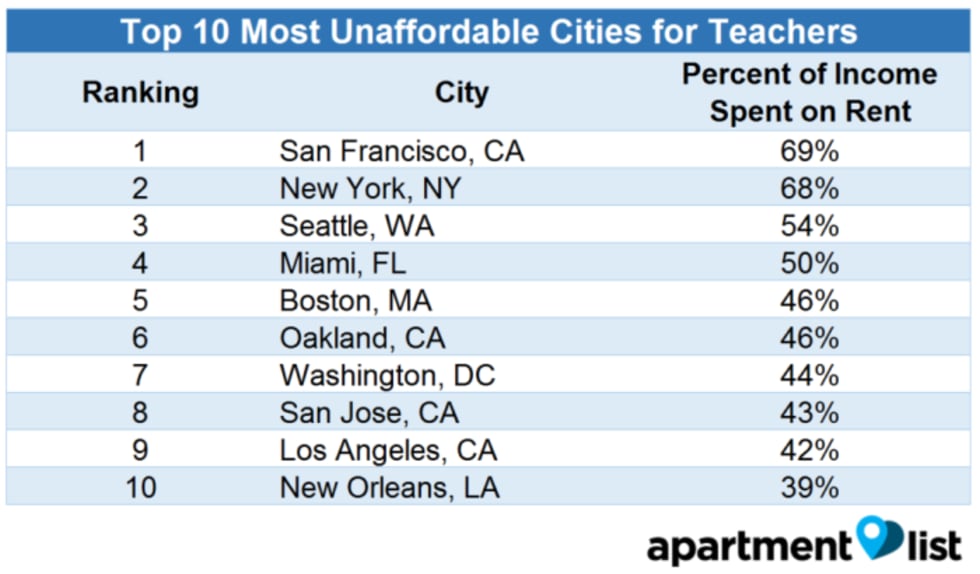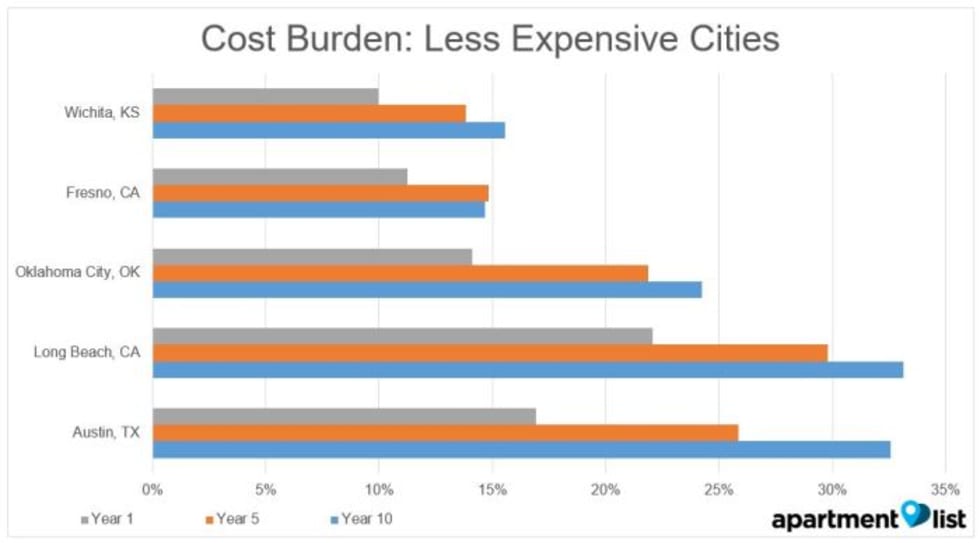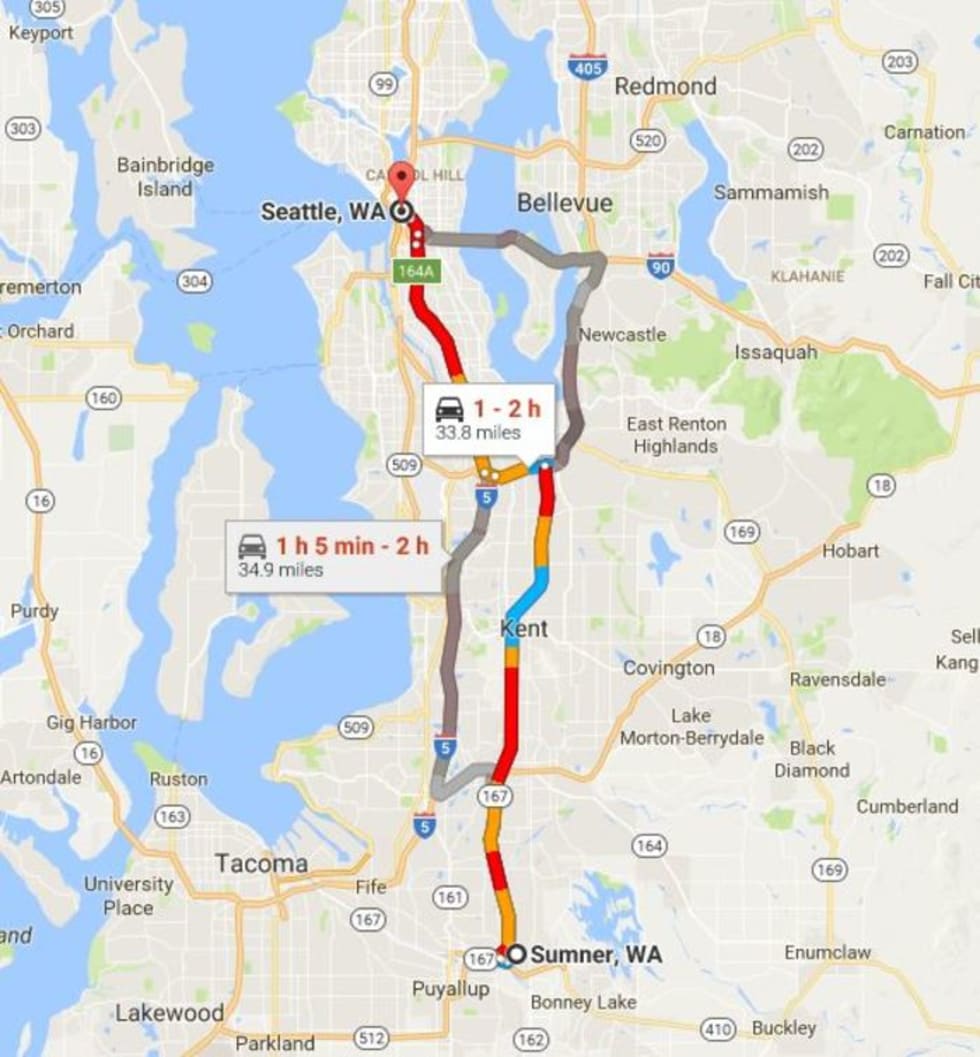Even Experienced Teachers Can't Afford to Live Where They Work

Teachers play an integral role in our society, educating and inspiring future generations of children. Despite this, their wages are lower than in many other professions. Low salaries and high attrition rates are resulting in a shortage of teachers nationwide.
To better understand the challenges facing our educators, we analyzed data on teacher salaries and median rents in 50 U.S. cities. In almost a third of cities (primarily located on the coasts), teachers spend more than 30% of their income on rent. For example, in San Francisco and New York fifth year teachers have to spend nearly 70% of their income to rent a one bedroom. Rents in many inland cities remain affordable for teachers.
The situation seems to worsen as teachers become more experienced, with fifth and tenth year teachers facing bigger challenges than first year teachers. Teachers facing rents far out of their price range often must decide between long commutes or financial stress. If these trends continue, city officials and school districts may face increasing struggles to attract and retain teachers.
Background
By educating future generations, teachers play a vital role in driving the success of our country. Despite the immense value teachers provide, they earn less than other comparable workers - and the gap is widening. In 2015, public school teachers earned 17% less than other comparable workers, up from -1.8% in 1994 and +5.5% in 1979. Lower comparable wages, high education costs, and rising rents have left teachers unable to afford to live where they teach.1
It’s no surprise that teachers - underpaid, under supported, and often unprepared - leave the profession at alarmingly high rates. Within the first five years, 17% of teachers leave the profession.2
The current teacher shortages mark a distinct departure from the massive teacher layoffs at the start of The Great Recession. During the 2015-2016 school year, there was a shortage of 60,000 teachers nationwide.3
If the U.S. attrition rate decreased from 8% to 4% - the rate in other highly educated countries - current teacher shortages would disappear.4 Recruitment and retention efforts cost the U.S. $2.2 billion annually, but are still not enough to fill all teaching positions with qualified candidates.5
Methodology
In order better understand the struggle teachers face when trying to live in the communities where they teach, we first obtained teacher salary schedules from public school district websites.6 We then compared salaries with median rents of properties listed on Apartment List to understand the affordability gap in 50 cities across the country. We calculated the percentage of income teachers must spend on rent to determine where teachers’ cost-burdens are the most severe.
Our analysis assumes that teachers’ housing needs evolve over the course of their career:
- First year teachers share a 2 bedroom apartment, paying half the rent
- Five years of experience rent their own 1 bedroom apartment
- Ten years of experience rent their own 2 bedroom apartment
Additionally, we assumed teachers gain more education as they advance in their careers. For example, in our calculations a fifth year teacher in DC would have a Bachelor's Degree plus 15 credits and a tenth year teacher would have a Master Degree or 30 credits.7 We have included additional details on our methodology in the article footnotes.8
Teacher salaries start between $33,000 and $57,000, then increase by about 2% each year
We looked at data on teacher salaries in 50 cities across the country. Teachers salary schedules generally reward teachers for both years of experience and pursuing additional education, as can be seen in the sample salary schedule from the District of Columbia Public Schools.9

The median starting salary was $43,493, significantly lower than the national average entry level college salary of $50,566.10 There is significant variation across the country, however, with the highest salaries offered in coastal cities like Los Angeles ($54,565) and Boston ($52,632), and relatively lower salaries in inland locations like Tulsa ($32,900) and Albuquerque ($34,000).
As teachers gain experience, their salaries go up by ~2% a year. These increases vary by school district - Philadelphia has pay increases of 4.3% a year, but New Orleans is basically flat over ten years (.4% annually). Overall, teachers' pay increases compare unfavorably with other industries, where salaries typically increase by 2.5- 3.0% each year.11 Teachers who obtain additional credits often receive pay raises, but these salary bumps come with significant out-of-pocket costs.
One bedroom rentals unaffordable for fifth year teachers in 15 out of 50 cities
Next, we compared teacher salary data with median rents in their respective cities. Housing remains unaffordable for teachers in many cities across the country, with fifth year teachers in 15 out of 50 cities spending more than 30% of their income in rent.
Coastal cities most unaffordable for teachers

Unsurprisingly, teachers are most cost-burdened in expensive cities on the coasts. For example, a fifth year teacher in Miami would have to spend 50% of their income on a one bedroom apartment. Coastal California rents are some of the most unaffordable for teachers, with teachers spending over 40% of their rent in four California cities.

Apartments are more affordable for teachers in the South, Southwest, and Midwest. For example, a fifth year teacher in Memphis would only need to spend 15% of their income on a one bedroom. Cities in the Southwest such as Albuquerque and Tucson also remain affordable for teachers.
Although school districts in more expensive cities pay higher salaries, they are unable to compensate for significantly more expensive rents. For example, rent for a one bedroom apartment in San Francisco is almost 7 times more expensive than in Wichita but teachers’ salaries in San Francisco are only around 40% higher.
Experienced teachers are more cost-burdened than entry level teachers in all 50 cities
When examining teacher salaries at different career points, we found that it’s not just entry level teachers who are cost-burdened. First year teachers were cost-burdened in 8 cities, 5th year teachers in 15 cities, and 10th year teachers in 21 cities. While young teachers willing to crowd into shared houses might be able to make ends meet in expensive cities, mid level teachers desiring their own space or hoping to start a family will struggle to find affordable housing.

In most cities, cost-burden increased as teachers gained experienced and moved into their own one and two bedroom apartments. For example, in Seattle a first year teacher spends 38% of their income on a shared two bedroom. A fifth year teacher needs to spend 54% of their income on a one bedroom and a tenth year teacher needs to spend 58% of their income on a two bedroom. In 11 cities, 10th year teachers must spend over 30% of their income on a one bedroom apartment.

The pattern of cost-burdens increasing for experienced teachers held true across both expensive and inexpensive cities. While first year teachers in Austin spent less than 20% of their income on a shared one bedroom, tenth year teachers must spend 33% of their income to afford their own two bedroom. For teachers who did not pursue additional education, cost-burdens were even more severe after five and ten years of teaching.
The decline of relative wages has affected experienced teachers more than entry level teachers, causing high turnover and shortages in the profession. Wages for mid level teachers are 21.8% lower than similar occupations, while that number is only 16.4% for young teachers.12 Even experienced teachers make significantly less than other professions, including professions that don’t require a college degree.13
- Corrections officers in Oakland earn $4,000 more than teachers with ten years of experience and 45 credits
- Bus drivers in Seattle make 20% than teachers with ten years of experience and 45 credits
- Boilermakers, mail carriers, construction and building operators, and power plant operators in Denver all make than teachers with ten years of experience and 45 credits
Cities offer few affordable options the surrounding metro
It's not just cities themselves that are unaffordable for teachers - in some cities, the surrounding areas are expensive as well. San Francisco and Seattle both offer few options for teachers hoping to save on rent by moving outside of the city.

In the San-Francisco metro, Pittsburg and San Pablo are the only cities where teachers can live without spending over 30% of their income on rent. For example, the median one bedroom rent in San Pablo is $1,150, around 23% of a fifth year teacher’s salary. Unfortunately both cities are over an hour away from San Francisco, putting a significant strain on teachers who chose to live there.14

In the Seattle metro, teachers can rent a one bedroom apartment in the suburb of Sumner for $800 a month, around 26% of a fifth year teacher’s monthly salary. Teachers who chose to live in Sumner will have to spend at least two hours commuting daily. Teachers priced out of urban markets sacrifice a significant amount of time each day commuting to the classroom, and may choose to teach in a different school district or leave the profession entirely.

Other unaffordable cities have more affordable options nearby, accessible by car or public transportation. For example, a teacher in Washington, DC can rent a one bedroom in Mount Rainier, MD for $1,035 month, compared to $2,081 in Washington, DC. The commute from Mount Rainier to DC takes around half an hour by car. DC also offers public transportation from many of the less expensive surrounding areas, but this option only works for teachers who live and work near metro stations.
Other expensive cities such as Boston, New York, Miami and San Jose offer affordable housing options with around a thirty minute commute, but affordable options are often limited to a few smaller suburbs.
What happens with low salaries and teacher shortages?
Although low salaries aren’t the only reason teachers leave the profession, they do play a role in high teacher turnover and shortages. Research shows both entry level and experienced teachers are more likely to quit in districts with lower wages, especially when salaries are low in comparison to alternative occupations in the area. Shortages are particularly severe in subjects with higher relative wages such as math and science.15
With low relative wages and high attrition rates, teacher shortages are expected to continue. The demand for teachers is predicted to increase 20% while supply continues shrinking, leading to a 100,000 qualified teacher shortage by 2025.16
As our analysis shows, school districts in expensive coastal cities risk losing both entry level and more experienced teachers because they can no longer afford to live where they teach. Teachers are forced to make the decision to find a higher paying job or move to a more affordable area. Salaries will likely need to rise in the costliest areas in order to meet the increasing demand for teachers in the years to come.
- Sylvia Allegretto and Lawrence Mishel, "The Teacher Pay Gap is Wider Than Ever." Economic Policy Institute, August 9, 2016, http://www.epi.org/publication/the-teacher-pay-gap-is-wider-than-ever-teachers-pay-continues-to-fall-further-behind-pay-of-comparable-workers↩
- Kristina Rizga, "Op-Ed: Why so many teachers quit, and how to fix that." Los Angeles Times, August 23, 2015, http://www.latimes.com/opinion/op-ed/la-oe-0823-rizga-mission-high-teacher-retention-20150823-story.html↩
- Lelb Sutcher, Linda Darling-Hammond, Desiree Carver-Thomas, "A Coming Crisis in Teaching? Teacher Supply, Demand, and Shortages in the U.S. Learning Policy Institute, September 15, 2016, https://learningpolicyinstitute.org/product/coming-crisis-teaching-brief↩
- Lelb Sutcher, Linda Darling-Hammond, Desiree Carver-Thomas, "A Coming Crisis in Teaching? Teacher Supply, Demand, and Shortages in the U.S. Learning Policy Institute, September 15, 2016, https://learningpolicyinstitute.org/product/coming-crisis-teaching-brief↩
- Kristina Rizga, "Op-Ed: Why so many teachers quit, and how to fix that." Los Angeles Times, August 23, 2015, http://www.latimes.com/opinion/op-ed/la-oe-0823-rizga-mission-high-teacher-retention-20150823-story.html↩
- We used teacher salaries schedules from the public school system within city boundaries. Our research is based on most recent school year available, generally 2016-2017 but 2015-2016 for select districts. For districts with multiple work year lengths, we used the middle length.↩
- In order to account for salary difference by education lane, we assumed fifth year teachers would be at lane two and tenth year teachers would be at lane three. For districts with no lane differences but a Masters Degree bonus, our year 5 and year 10 salaries include that bonus. For school districts with no salary differences for education levels we used salaries based on years of experience alone.↩
- Rent data is based on the median 1 and 2 bedroom prices for properties listed on Apartment List.↩
- District of Colombia Public Schools, “Base Salary,” 2016-2017, https://dcps.dc.gov/page/compensation-and-benefits-teachers↩
- Susie Poppick, "Here's What the Average Grad Makes Right Out of College." Time, April 22, 2015, http://time.com/money/collection-post/3829776/heres-what-the-average-grad-makes-right-out-of-college/↩
- "US Compensation Planning Survey." Mercer, 2017, https://www.imercer.com/ECommerce/products/compensation-planning-survey?isPartOpen=true↩
- Lelb Sutcher, Linda Darling-Hammond, Desiree Carver-Thomas, "A Coming Crisis in Teaching? Teacher Supply, Demand, and Shortages in the U.S. Learning Policy Institute, September 15, 2016, https://learningpolicyinstitute.org/product/coming-crisis-teaching-brief↩
- Bureau of Labor Statistics, “OESM15MA,” 2015 accessed at https://www.bls.gov/bls/blswage.htm↩
- Commute times are based on arriving by 8:00am on 4/17/2017↩
- Lelb Sutcher, Linda Darling-Hammond, Desiree Carver-Thomas, "A Coming Crisis in Teaching? Teacher Supply, Demand, and Shortages in the U.S. Learning Policy Institute, September 15, 2016, https://learningpolicyinstitute.org/product/coming-crisis-teaching-brief↩
- Lelb Sutcher, Linda Darling-Hammond, Desiree Carver-Thomas, "A Coming Crisis in Teaching? Teacher Supply, Demand, and Shortages in the U.S. Learning Policy Institute, September 15, 2016, https://learningpolicyinstitute.org/product/coming-crisis-teaching-brief↩
Share this Article
